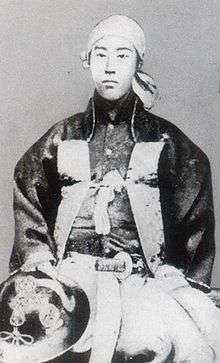Fudai daimyō

Fudai daimyō (譜代大名) was a class of daimyō who were hereditary vassals of the Tokugawa in Edo-period Japan.[1] It was primarily the fudai who filled the ranks of the Tokugawa administration.
Origins
Many of the families who formed the ranks of the fudai daimyō were families which had served the Tokugawa clan since before its rise to national primacy. Some of these include the Honda, Sakai, Sakakibara, Ii, Itakura, and Mizuno clans. Tokugawa Ieyasu's "Four Great Generals"—Honda Tadakatsu, Sakakibara Yasumasa, Sakai Tadatsugu, and Ii Naomasa—were all pre-Edo era fudai, and went on to become fudai daimyō. In addition, some branches of the Matsudaira clan (from which the Tokugawa clan originated), while allowed to retain the Matsudaira surname, were fudai.
In the Edo period
As Tokugawa Ieyasu rose to power in the 16th century, his domains increased, and as his domains increased, he began to hand out landholdings to his vassals, so that one by one, many of them became daimyō. This was the birth of the fudai daimyo class. In contrast to the tozama, the fudai typically ruled small fiefs, many in strategic locations along the principal roads or in the Kantō region near the headquarters of the shogunate at Edo.[2] High posts in the shogunate, such as Rōjū and wakadoshiyori, normally went to fudai. In addition, the post of Kyoto Shoshidai almost always went to a fudai daimyō.
Other clans which were not pre-Azuchi–Momoyama period retainers of the Tokugawa also came to be counted as fudai: the Ogasawara and Doi are among them.
Occasionally, a family could be raised to or from fudai status. For instance, the Matsudaira clan to which Matsudaira Sadanobu belonged went from being a fudai[3] house to being a recognized relative of the Tokugawa family.[4] Also, a hatamoto who had an increase in income which raised his income level over 10,000 koku became a fudai daimyō.
Bakumatsu and beyond

Many fudai daimyo were involved in the vigorous political activity of the Bakumatsu, as well as the renewed military activities which occurred in that period. Two such men of fudai daimyo background were Ogasawara Nagamichi[5] and Itakura Katsukiyo,[6] who were two of the last rōjū, and actively worked for reform and strengthening of the ailing shogunate. Others, such as Matsudaira Munehide, were involved in diplomacy and foreign affairs.
In the Boshin War of 1868–69, some fudai houses such as the Toda of Ogaki and the Tōdō of Tsu sided with the Shogunate during the first battle at Toba-Fushimi. However, after the shogunate's loss there, many fudai houses did not side with the shogunate or with the shogun's former army which moved northward and eventually set up the Ezo Republic.[7] Some remained neutral, while others (like the lords of Ōgaki and Tsu) switched allegiances and openly supported the Imperial Japanese Army. Ogasawara Nagamichi and Itakura Katsukiyo led small groups of their retainers during the fight against the imperial forces. However, their domains had already been occupied by the imperial army, and were forced to participate in the war on the imperial army's behalf.[8] Only one fudai daimyo, Hayashi Tadataka of the Jōzai Domain, willingly left his domain early in 1868, and led most of his retainer force on behalf of the armies of the former shogun, in the fight against the imperial army.[9] Also, a handful of fudai in the far north formed part of the Northern Alliance, fighting for the Alliance but not for the now-retired shogun.
Most of the fudai in the country entered the Meiji era peacefully, and ruled their domains until the domains' dissolution in 1871. After this, the former families of fudai daimyo became peers in the new Japanese nobility system.
Notes
- ↑ Nussbaum, Louis Frédéric et al. (2005). "Fudai" in Japan encyclopedia, pp. 193–194., p. 193, at Google Books; n.b., Louis-Frédéric is pseudonym of Louis-Frédéric Nussbaum, see Deutsche Nationalbibliothek Authority File.
- ↑ Ooms, pp. 14–15
- ↑ (Japanese) "Takada-han" on Edo 300 HTML (14 March 2008)
- ↑ (Japanese) "Shirakawa-han" on Edo 300 HTML (14 March 2008)
- ↑ Ogasawara was from a daimyo family (the Ogasawara of the Karatsu Domain), but was not an actual daimyo
- ↑ Itakura was lord of Bitchū-Matsuyama
- ↑ Bolitho, p. 145.
- ↑ (Japanese) "Karatsu-han" (14 March 2008)
- ↑ Yamakawa, Aizu Boshin Senshi, p. 505.
References
- Bolitho, Harold. (1974). Treasures Among Men: The Fudai Daimyo in Tokugawa Japan. New Haven: Yale University Press. ISBN 978-0-300-01655-0; OCLC 185685588
- Nussbaum, Louis Frédéric and Käthe Roth. (2005). Japan Encyclopedia. Cambridge: Harvard University Press. ISBN 978-0-674-01753-5; OCLC 48943301
- Ooms, Herman (1975). Charismatic Bureaucrat. Chicago: University of Chicago Press.
- (Japanese) "Karatsu-han" (14 March 2008)
- Yamakawa Kenjiro (1933). Aizu Boshin Senshi. Tokyo: Tokyo Daigaku Shuppankai.
- (Japanese) "Takada-han" on Edo 300 HTML (14 March 2008)
- (Japanese) "Shirakawa-han" on Edo 300 HTML (14 March 2008)